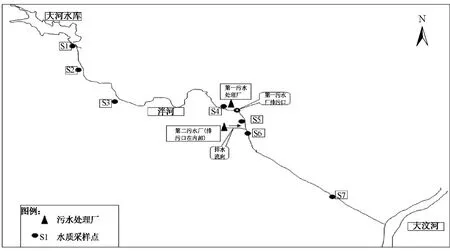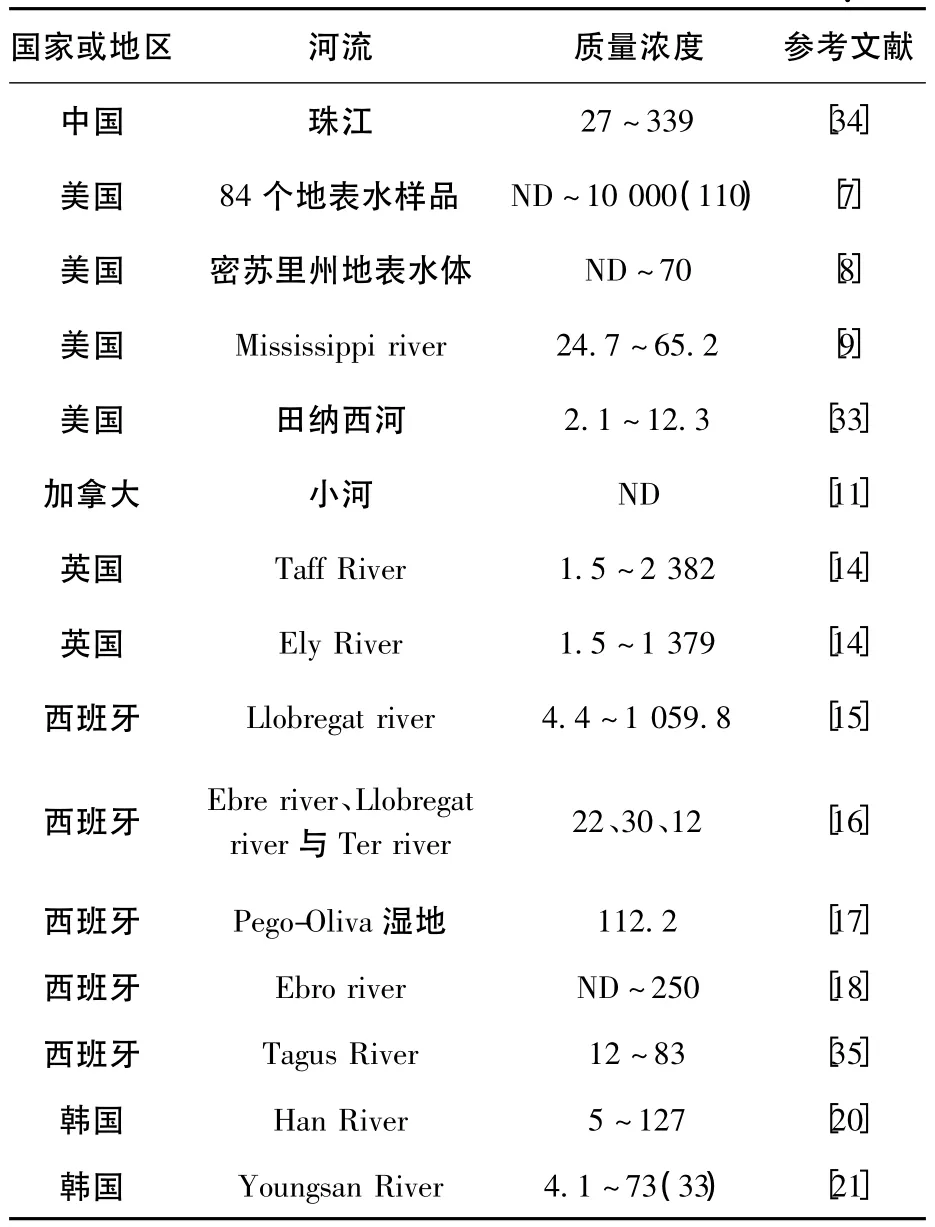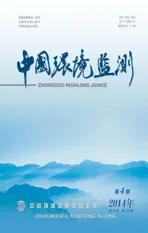污水处理厂进出水及其受纳水体中典型PPCPs的污染特征
2014-10-12王凤花曹建峰闫赛红
王凤花,宋 鑫,曹建峰,闫赛红,张 燕
1.山东农业大学资源与环境学院,土肥资源高效利用国家工程实验室,山东 泰安 271018
2.山东省高校农业与环境重点实验室,山东 泰安 271018
3.美国西北大学土木与环境工程系,伊利诺伊 埃文斯顿 60208
4.泰安市环境保护监测站,山东 泰安 271000
5.泰安市岱岳区环境保护局,山东 泰安 271000
药品及个人护理品(PPCPs)是近十几年来逐渐引起关注的一类新兴污染物,包括所有人与兽用的药物、诊断剂、保健品、麝香、防晒剂、消毒剂和化妆品等[1],在环境中的残留及其潜在的生态环境毒性成为近几年环境化学领域关注的热点[2-3]。
对乙酰氨基酚又名扑热息痛,是一种最常用的非甾体类解热镇痛药,被用作阿司匹林的替代物以缓解发烧、头痛等[4],属于非处方药。该药物全球消费量约7万 t,现有9万 t的生产能力,其中美国的生产能力达4万t,我国年产对乙酰氨基酚4.5万t,巨大的产量和消费量使对乙酰氨基酚成为非常重要的研究对象[5-6]。该药物经过人体代谢后由生活污水排入污水处理厂,经处理后的污水排入地表水体,因此作为潜在的环境污染物引起了环境学界的广泛关注。在世界各国的地表水体如美国[7-10]、加拿大[11]、法国[12-13]、英国[14]、西班牙[15-19]、韩国[20-21]等频繁检测到该种药物,在我国,珠江三角洲和台湾地区[22-23]也检测到了该药物,而污水处理厂进出水中也大量检测到该药物[24-29]。
泮河位于山东省泰安市,发源于泰山主峰以西大河水库,流经泰安市区后汇入大汶河,流域面积368 km2,河长约为 42 km,河宽为 30~40 m[30]。大汶河是南水北调东线工程主要调蓄水库-东平湖的惟一汇入河流,因此泮河的污染状况对南水北调东线工程意义重大[31]。由于泮河流经人口稠密的泰安市区,泰安市第一和第二污水处理厂位于泮河中游,处理后的排水均进入该河流,因此调查污水处理厂进出水和泮河中对乙酰氨基酚的污染状况,对于分析人为活动对该药物的排放影响、污水处理厂排水对该药物的浓度贡献,把握南水北调东线工程水质并提出水质改善建议,保护人体健康,具有重要意义。该研究以泰安市第一和第二污水处厂以及受纳水体泮河作为研究对象,通过监测污水处理厂进出水和泮河中的对乙酰氨基酚含量,分析该药物活性成分在污水处理厂进出水和地表水体中的污染特征。
1 实验部分
1.1 仪器与试剂
对乙酰氨基酚对照品(中国药品生物制品检定所,100018-200408)。甲醇为色谱纯,其余试剂均为化学纯,实验用水为高纯水。
固相萃取柱(Cleanert C18,500 mg/3 mL)、固相萃取装置(GL Sciencs)、1100高效液相色谱仪(UV检测器)、溶剂过滤器(HP01真空泵+HL01过滤瓶),KQ-250E超声波清洗器,过滤膜(0.45 μm,醋酸纤维)。
1.2 样品的采集
2012年3—5月分别在泰安市第一和第二污水处理厂进水口、出水口及其出水受纳河流采集样品,各采样点位置见图1。用棕色瓶采集混合水样,水样采集后,置于4℃冰箱保存备用。

图1 地表水采样点和污水处理厂分布示意图
1.3 样品前处理
水样经0.45 μm滤膜过滤后经固相萃取净化。选用C18固相萃取柱为净化柱,使用前预先用10 mL甲醇、10 mL水活化,再将过滤后的水样以5 mL/min的速度通过萃取柱,然后用2 mL超纯水淋洗小柱,真空干燥15~20 min后,用甲醇洗脱目标物,收集洗脱液并在氮气流下吹至近干后用甲醇定容至 5 mL[32],过滤,转至样品瓶中,进行液相色谱分析。
1.4 仪器分析
采用高效液相色谱-紫外检测器分析样品中目标组分,色谱柱为 Eclipse XDB-C18色谱柱(250 mm ×4.6 mm,5 μm);流动相:A 液为甲醇,B液为超纯水,甲醇与水的体积比为28∶72;流速1.0 mL/min;柱温为 25 ℃;进样量 10 μL。检测波长 243 nm[9];对乙酰氨基酚的保留时间为4 min;采用外标法定量。
2 结果与讨论
2.1 线性范围、检测限和回收率
配制质 量 浓度 为 0.01、0.05、0.10、0.50、1.0、5.0、10.0 mg/L 的对乙酰氨基酚系列标准溶液,在上述色谱条件下分析并制图,得到线性方程y=41.896x(其中 y为峰面积,x为进样浓度),相关系数为0.999 8。由标准曲线可以看出,对乙酰氨基酚在0.01~10 mg/L内呈良好的线性。方法检测限为1.0 ng/L。在不含对乙酰氨基酚的空白水样中添加标准溶液,进行回收率实验。回收率为86.6% ~92.8%,相对标准偏差为 1.56% ~3.96%。方法的灵敏度和准确性能够满足水体中对乙酰氨基酚的分析要求。
2.2 地表水体中对乙酰氨基酚的污染状况
经检测,泮河中对乙酰氨基酚的质量浓度为ND ~3.59 μg/L,详见表1。

表1 泮河中对乙酰氨基酚的质量浓度/ μg/L
由表1可以看出,除了泮河的发源地大河水库出口处和污水处理厂下游3 km处的采样点外,其他各采样点均检出了该药物成分。采样点S3处药物含量最高,因该采样点位于人口稠密地区,可能是由人为排放污水进入泮河导致;泰安市第一污水处理厂排水口上游100 m处,对乙酰氨基酚的含量不高,可能是该药物在河流中经过了部分生物降解和吸附[23];对乙酰氨基酚在第一污水处理厂排水口下游含量高于上游含量,表明污水处理厂排水是泮河中该药物的主要来源[33]。第二污水处理厂主要接纳工业废水,所以排水口下游100 m处对乙酰氨基酚的含量变化不大;经过约3 km的降解后,S7采样点的含量明显降低。生物降解和光解是对乙酰氨基酚在河水中降解的主要机理[34]。
2.3 污水处理厂进出水中对乙酰氨基酚的含量水平
泰安市第一、第二污水处理厂的情况见表2。

表2 泰安市第一、第二污水处理厂概况
第一污水处理厂进水中对乙酰氨基酚质量浓度为15~238 μg/L,出水中质量浓度为 ND ~8.3 μg/L,去除率约为97.4%。第二污水处理厂进水中对乙酰氨基酚质量浓度为0.9~63.6 μg/L,出水中质量浓度为 ND~3.9 μg/L,去除率约为96.8% 。
2.4 与国内外研究结果的比较
我国目前还没有关于PPCPs的排放标准要求,为了更清楚地了解对乙酰氨基酚的污染状况,将测定结果与国内外的研究结果进行了比较。
2.4.1 世界各地区地表水中对乙酰氨基酚的污染状况
关于对乙酰氨基酚在地表水中污染状况的报道,目前国内研究较少,集中在珠江三角洲和台湾地区,而国外研究较多,主要包括北美、欧洲和韩国地区,见表3。
世界各地区的研究结果表明,对乙酰氨基酚是地表水中普遍存在的污染物之一[14,18,20-22,36],且检出含量较高,说明该药物作为非处方药,在人群中使用广泛。而不同采样点中,下游水体的药物含量高于上游水体,可能是由于污水处理厂排水作用导致[13-14,21]。随着距污水厂排水口距离的增加,浓度逐渐下降[23],甚至没有检出[19]。同时,西班牙的检测结果表明,对乙酰氨基酚在地表水中的含量与人为活动有关,人口稠密地区的水体中含量高,人为活动影响小的地区,该药物的含量也小[15-17],这也与本研究结果相似。

表3 地表水中对乙酰氨基酚质量浓度的国内外比较μg/L
对乙酰氨基酚只用于人类不用于家禽/家畜,同时由于该药物的临床应用频率极高,且在污水处理厂中易去除,因此,有学者建议将对乙酰氨基酚作为未处理的城市排水引起污染的极好的半定量指示物[12]。
比较研究结果可以看出,本研究中对乙酰氨基酚的浓度水平与上述研究结果处在同一个数量级。
2.4.2 世界各国污水处理厂进出水中对乙酰氨基酚的含量范围
世界各国污水处理厂进出水中对乙酰氨基酚的质量浓度见表4。由表4可以看出,污水处理厂进水中对乙酰氨基酚的质量浓度很高,原因是该药物不经过处方就可以买到,消费量大[37]。但污水厂去除对乙酰氨基酚的效率也很高[42],且与处理过程无关。生物降解是主要的去除途径[23]。

表4 部分国家污水处理厂进出水中对乙酰氨基酚的质量浓度
3 结论
泰安市污水处理厂进出水中对乙酰氨基酚的质量浓度分别为 0.9~238 μg/L和 ND~8.3 μg/L,与其他研究结果相比处于同一个数量级。该药物在泰安市地表水中的质量浓度为ND~3.59 μg/L,在世界范围内属于中等污染水平。目前的研究结果表明,对乙酰氨基酚是地表水中检出浓度和检出率最高的药物之一,且具有较高的生态风险,因此其生态风险应引起重视,而在这方面的研究很少,所以迫切需要在对乙酰氨基酚对陆地和水生生态系统的毒性方面展开研究。
[1]Daughton C G,Ternes T A.Pharmaceuticals and personal care products in the environment:agents of subtle change[J].Environ Health Persp,1999,107(S6):907-938.
[2]Hernando M D,Mezcua M,Fernández-Alba A R,et al.Environmental risk assessment of pharmaceutical residues in wastewater effluents,surface waters and sediments[J].Talanta,2006,69(2):334-342.
[3]Straub J O,Hutchinson T H.Environmental Risk Assessment for Human Pharmaceuticals:The Current State of International Regulations[M].New York:Springer,2012:17-47.
[4]Bosch M E,Ruiz Sanchez A J,Rojas F S,et al.Determination of paracetamol: Historical evolution[J].J Pharmaceut Biomed,2006,42:291-321.
[5]陈鹏宇,张旭,吴峰,等.TiO2光催化降解水中对乙酰氨基酚的研究[J].安全与环境工程,2007,14(3):40-42.
[6]李湛,张旭,陈鹏宇,等.对乙酰氨基酚在Fe(Ⅲ)/草酸盐体系中的光降解[J].化学研究与应用,2008,9:1 181-1 184.
[7]Kolpin D, Furlong E, Thurman E, et al.Pharmaceuticals, hormones, and other organic wastewater contaminants in U.S.streams,1999—2000:a national reconnaissance[J].Environ Sci &Technol,2002,36:1 202-1 211.
[8]Wang C,Shi H L,Adams C D,et al.Investigation of pharmaceuticals in Missouri natural and drinking water using high performance liquid chromatography-tandem mass spectrometry[J].Water Res,2011,45:1 818-1 828.
[9]Zhang S Y,Zhang Q,Darisaw S,et al.Simultaneous quantification of polycyclic aromatic hydrocarbons(PAHs),polychlorinated biphenyls(PCBs),and pharmaceuticals and personal care products(PPCPs)in Mississippi river water,in New Orleans,Louisiana,USA[J].Chemosphere,2007,66:1 057-1 069.
[10]Conley J M,Symes S J,Schorr M S,et al.Spatial and temporal analysis of pharmaceutical concentrations in the upper Tennessee River basin[J].Chemosphere,2008,73:1 178-1 187.
[11]Shaaban H,Górecki T.Fast ultrahigh performance liquid chromatographic method for the simultaneous determination of 25 emerging contaminants in surface water and wastewater samples using superficially porous sub-3 mm particles as an alternative to fully porous sub-2 mm particles[J].Talanta,2012,100:80-89.
[12]Vulliet E,Cren-Olivé C.Screening of pharmaceuticals and hormones at the regional scale,in surface and groundwaters intended to human consumption[J].Environ Pollut,2011,159:2 929-2 934.
[13]Rabiet M,Togola A,Brissaud F,et al.Consequences of treated water recycling as regards pharmaceuticals and drugs in surface and ground waters of a mediumsized Mediterranean catchment[J].Environ Sci &Technol,2006,40:5 282-5 288.
[14]Kasprzyk-Hordern B,Dinsdale R M,Guwy A J.The occurrence of pharmaceuticals,personal care products,endocrine disruptors and illicit drugs in surface water in South Wales,UK[J].Water Res,2008,42:3 498-3 518.
[15]Osorio V,Marcé R,Pérez S,et al.Occurrence and modeling of pharmaceuticals on a sewage-impacted Mediterranean river and their dynamics under different hydrological conditions[J].Sci Total Environ,2012,440:3-13.
[16]Pedrouzo M,Revert S,Borrull F,et al.Pharmaceutical determination in surface and wastewaters using highperformance liquid chromatography-(electrospray)-mass spectrometry[J].J Sep Sci,2007,30:297-303.
[17]Vazquez-Roig P,Andreu V,Blasco C,et al.Risk assessment on the presence of pharmaceuticals in sediments,soils and waters of the Pego-Oliva Marshlands(Valencia,eastern Spain)[J].Sci Total Environ,2012,440:24-32.
[18]Gros M,Petrovíc M,Barceló D.Development of a multi-residue analytical methodology based on liquid chromatography-tandem mass spectrometry(LC-MS/MS)for screening and trace level determination of pharmaceuticals in surface and wastewaters[J].Talanta,2006,70:678-690.
[19]Camacho-Munoz D,Martin J,Luis Santos J,et al.An affordable method for the simultaneous determination of the most studied pharmaceutical compounds as wastewater and surface water pollutants[J].J Sep Sci,2009,32:3 064-3 073.
[20]Choi K,Kim Y,Park J,et al.Seasonal variations of several pharmaceutical residues in surface water and sewage treatment plants of Han River,Korea[J].Sci Total Environ,2008,405:120-128.
[21]Kim S D,Cho J,Kim I S,et al.Occurrence and removal of pharmaceuticals and endocrine disruptors in South Korean surface,drinking,and waste waters[J].Water Res,2007,41:1 013-1 021.
[22]Lin A Y C,Tsai Y T.Occurrence of pharmaceuticals in Taiwan's surface waters:Impact of waste streams from hospitals and pharmaceutical production facilities[J].Sci Total Environ,2009,407:3 793-3 802.
[23]Lin A Y C,Lin C A,Tung H H,et al.Potential for biodegradation and sorption of acetaminophen,caffeine,propranolol and acebutolol in lab-scale aqueous environments[J].J Hazard Mater,2010,183:242-250.
[24]Behera S K,Kim H W,Oh J E,et al.Occurrence and removal of antibiotics,hormones and several other pharmaceuticals in wastewater treatment plants of the largest industrial city of Korea[J].Sci Total Environ,2011,409:4 351-4 360.
[25]Gao P, Ding Y J, Li H, et al.Occurrence ofpharmaceuticals in a municipal wastewater treatment plant:Mass balance and removal processes[J].Chemosphere,2012,88:17-24.
[26]Yu Y,Wu L S,Chang A C.Seasonal variation of endocrine disrupting compounds,pharmaceuticals and personal care products in wastewater treatment plants[J].Sci Total Environ,2013,442:310-316.
[27]Martínez Bueno M J,Gomez M J,Herrera S,et al.Occurrence and persistence of organic emerging contaminants and priority pollutants in five sewage treatment plants of Spain:Two years pilot survey monitoring[J].Environ Pollut,2012,164:267-273.
[28]Bisceglia K J,Yu J T,Coelhan M,et al.Trace determination of pharmaceuticals and other wastewaterderived micropollutants by solid phase extraction and gas chromatography/mass spectrometry[J].J Chromatogr A,2010,1 217:558-564.
[29]Pedrouzo M,Borrull F,Pocurull E,et al.Presence of Pharmaceuticals and Hormones in Waters from Sewage Treatment Plants[J].Water Air Soil Pollut,2011,217:267-281.
[30]张中文,李光德,张世远,等.泮河底泥中重金属污染及潜在生态危害评价[J].环境科学与技术,2008,31(11):134-136,153.
[31]苏秋红,李光德,孙强生,等.泮河底泥重金属分布特征及污染评价[J].山东农业大学学报:自然科学版,2007,38(3):419-423.
[32]黄晓兰,许玫英.高效液相色谱法同时测定制药废水中的交沙霉素、茶碱及扑热息痛[J].色谱,2005,23(3):296-298.
[33]Gómez M J,Martínez B M J,Lacorte S,et al.Pilot survey monitoring pharmaceuticals and related compounds in a sewage treatment plant located on the Mediterranean coast[J].Chemosphere,2007,66:993-1 002.
[34]Yang X,Chen F,Meng F G,et al.Occurrence and fate of PPCPs and correlations with water quality parameters in urban riverine waters of the Pearl River Delta,South China[J].Environ Sci Pollut Res,2013,20:5 864-5 875.
[35]Valcárcel Y,González Alonso S,Rodríguez-Gil J L,et al.Seasonal variation of pharmaceutically active compounds in surface(Tagus River)and tap water(Central Spain) [J].Environ Sci Pollut Res,2013,20:1 396-1 412.
[36]Tewari S, Jindal R, Kho Y L, et al.Major pharmaceutical residues in wastewater treatment plants and receiving waters in Bangkok, Thailand, and associated ecological risks[J].Chemosphere,2013,91:697-704.
[37]Behera S K,Kim H W,Oh J E,et al.Occurrence and removal of antibiotics,hormones and several other pharmaceuticals in wastewater treatment plants of the largest industrial city of Korea[J].Sci Total Environ,2011,409:4 351-4 360.
[38]Rosal R,Rodríguez A,Perdigón-Melón J A,et al.Occurrence of emerging pollutants in urban wastewater and their removal through biological treatment followed by ozonation[J].Water res,2010,44:578-588.
[39]Matsuo H,Sakamoto H,Arizono K,et al.Behavior of Pharmaceuticals in Waste Water Treatment Plant in Japan[J].Bull Environ Contam Toxicol,2011,87:31-35.
[40]Dahane S,García M D G,Bueno M J M,et al.Determination of drugs in river and wastewaters using solid-phase extraction by packed multi-walled carbon nanotubes and liquid chromatography-quadrupole-linear ion trap-mass spectrometry[J].J Chromatogr A,2013,1 297:17-28.
[41]Lee E, Lee S, Park J, et al.Removal and transformation of pharmaceuticals in wastewater treatment plants and constructed wetlands[J].Drink Water Eng Sci Discuss,2013,6:97-117.
[42]Rojas M R,Leung C,Bonk F,et al.Assessment of the Effectiveness of Secondary Wastewater Treatment Technologies to Remove Trace Chemicals of Emerging Concern[J].Cri Rev Env Sci Tec,2013,43(12):1 281-1 314.
